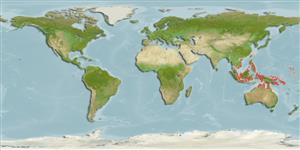>
Eupercaria/misc (Various families in series Eupercaria) >
Labridae (Wrasses) > Corinae
Etymology: Halichoeres: Greek, als, alis = salt + Greek, choiros = pig (Ref. 45335); erdmanni: Named for Mark V. Erdmann, who collected the holotype and 3 of the paratypes..
More on authors: Randall & Allen.
Environment: milieu / climate zone / depth range / distribution range
Ecologie
marien rifbewoner; diepte 8 - 25 m (Ref. 85096). Tropical
Western Pacific: northern Gulf of Thailand, Singapore, and Berau Bay, West Papua, Indonesia.
Grootte / Gewicht / Leeftijd
Maturity: Lm ? range ? - ? cm
Max length : 7.2 cm SL mannelijk / geslacht onbekend; (Ref. 85096); 5.9 cm SL (female)
Korte beschrijving
Morfologie | Morfometrie
Dorsale stekels (totaal): 9; Dorsale zachte stralen (totaal): 11; Anale stekels 3; Anale zachte stralen: 10; Wervels: 25. D IX,11; A III,10-12 (usually 11); pectoral rays 14 (including very small uppermost ray); lateral-line scales 27 (one of ten with 28); head naked; nape fully scaled; most scales of straight anterior part of lateral line with two diverging surface tubules ending in a pore; suborbital pores 6 or 7; gill rakers 18-20; body depth 3.2-3.45 in SL; head length (HL) 2.9-3.0 in SL; snout length 2.85-3.25 in HL; dorsal spines progressively longer, the ninth 2.7-3.3 in HL; caudal fin slightly rounded, 1.35-1.45 in HL; small adults in alcohol have the dorsal half of body with alternating dusky and pale stripes following longitudinal scale rows anteriorly, the pale stripes centered along scales, changing posterior to pectoral fins to a pale spot on each scale; six groups of 3-8 small dark spots (one per scale) along side of body, the first beginning above outer part of pectoral fin; nape with small dark spots; a vertically elongate dark spot posteriorly on opercular flap; a dark band on side of snout from eye to base of upper lip; triangular black spot dorsally on base of pectoral fin, continuing above fin base and enclosing a small pale spot; an irregular black spot in dorsal fin between 5ht and 7th spines; fins otherwise pale except for scaled basal part of caudal fin coloured like body; large males lose the groups of small dark brown spots on the body (Ref. 85096).
The species was found along the coasts of the islands, a combination of mangrove, rocky shore, and an occasional sand beach; the inshore habitat of the islands consists of low-diversity, fringing coral reef exposed to turbidity and siltation, underwater visibility often less than 3 m where the tidal current can be very strong (Ref. 85096).
Levenscyclus en paargedrag
Maturiteit | Voortplanting | Paaien | Eieren | Fecunditeit | Larven
Distinct pairing during breeding (Ref. 205).
Randall, J.E. and G.R. Allen, 2010. Two new labrid fishes of the genus Halichoeres from the East Indies. The Raffles Bull. Zool. 58(2):281-289. (Ref. 85096)
Status op de Rode Lijst van het IUCN (Ref. 130435)
Gevaar voor de mens
Harmless
Gebruik door de mens
Meer informatie
Leeftijd/GrootteGroeiLengte-gewichtLengte-lengteLengtefrequentiesMorfometrieMorfologieLarvenLarvale populatiedynamiekRekruteringAbundantieBRUVS
ReferentiesAquacultuurAquacultuurprofielKweeklijnenGeneticaElectrophoresesErfelijkheidZiektesVerwerkingNutrientsMassaconversie
Tools
Speciale rapporten
Download XML
Internetbronnen
Estimates based on models
Preferred temperature (Ref.
123201): 28.6 - 29.2, mean 28.9 °C (based on 770 cells).
Fylogenetische diversiteitsindex (Ref.
82804): PD
50 = 0.5000 [Uniqueness, from 0.5 = low to 2.0 = high].
Bayesian length-weight: a=0.00955 (0.00451 - 0.02020), b=3.09 (2.92 - 3.26), in cm total length, based on LWR estimates for this Genus-body shape (Ref.
93245).
Trofisch niveau (Ref.
69278): 3.3 ±0.5 se; based on size and trophs of closest relatives
Fishing Vulnerability (Ref.
59153): Low vulnerability (10 of 100).
Nutrients (Ref.
124155): Calcium = 144 [82, 269] mg/100g; Iron = 0.913 [0.514, 1.744] mg/100g; Protein = 18.3 [15.4, 20.5] %; Omega3 = 0.172 [0.100, 0.296] g/100g; Selenium = 20.8 [11.0, 39.9] μg/100g; VitaminA = 187 [54, 749] μg/100g; Zinc = 2.25 [1.48, 3.62] mg/100g (wet weight);
